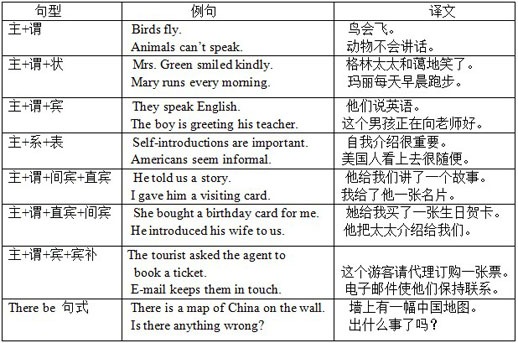
第十二讲
Sentence Writing
Basic Sentence Structure
英语的基本句型有以下8种:

Grammar: 英语的基本句型
英语五种基本句型列式如下:
基本句型一: S V (主+谓)
基本句型二: S V P (主+谓+表)
基本句型三: S V O (主+谓+宾)
基本句型四: S V o O (主+谓+间宾+直宾)
基本句型五: S V O C (主+谓+宾+宾补)
(一) 基本句型 一
此句型的句子有一个共同特点,即句子的谓语动词都能表达完整的意思。这类动词叫做不及物动词,后面可以跟副词、介词短语、状语从句等。
S │ V (不及物动词)
1. The sun │was shining.
2. The moon │rose.
3. The universe │remains.
4. We all │breathe, eat, and drink.
5. Who │cares?
6. What he said │does not matter.
7. They │talked for half an hour.
8. The pen │writes smoothly
1. 太阳在照耀着。 2. 月亮升起了。
3. 宇宙长存。 4. 我们大家都呼吸、吃和喝。
5. 管它呢? 6. 他所讲的没有什么关系。
7. 他们谈了半个小时。 8. 这支笔书写流利。
(二)基本句型 二
此句型的句子有一个共同的特点:句子谓语动词都不能表达一个完整的意思,必须加上一个表明主语身份或状态的表语构成复合谓语,才能表达完整的意思。这类动 词叫做连系动词。系动词分两类:be, look, keep, seem等属一类,表示情况;get, grow, become, turn等属另一类,表示变化。be 本身没有什么意义,只起连系主语和表语的作用。其它系动词仍保持其部分词义。
S │V(是系动词)│ P
1. This │is │an English-Chinese dictionary.
2. The dinner │smells │good.
3. He │fell │in love.
4. Everything │looks │different.
5. He │is growing │tall and strong.
6. The trouble│is │that they are short of money.
7. Our well │has gone │dry.
8. His face │turned │red.
1. 这是本英汉辞典。 2. 午餐的气味很好。
3. 他堕入了情网。 4. 一切看来都不同了。
5. 他长得又高又壮。 6. 麻烦的是他们缺少钱。
7. 我们的井干枯了。 8. 他的脸红了。
(三)基本句型 三
此句型句子的共同特点是:谓语动词都具有实义,都是主语产生的动作,但不能表达完整的意思,必须跟有一个宾语,即动作的承受者,才能使意思完整。这类动词叫做及物动词。
S │V(及物动词)│ O
1. Who │knows │the answer?
2. She │smiled │her thanks.
3. He │has refused │to help them.
4. He │enjoys │reading.
5. They │ate │what was left over.
6. He │said │"Good morning."
7. I │want │to have a cup of tea.
8. He │admits │that he was mistaken.
1. 谁知道答案? 2. 她微笑表示感谢。
3. 他拒绝帮他们的忙。 4. 他喜欢看书。
5. 他们吃了剩饭。 6. 他说:“早上好!”
7. 我想喝杯茶。 8. 他承认犯了错误。
(四)基本句型 四
此句型的句子有一个共同特点:谓语动词必须跟有两个宾语才能表达完整的意思。这两个宾语一个是动作的直接承受者,另一个是动作的间接承受者。通常这一间接 承受者用一个介词来连接,当动作的间接承受者在动作的直接承受者之前时,这一介词往往被省略。S │V(及物)│ o(多指人) │ O(多指物)
1. She │ordered │herself │a new dress.
2. She │cooked │her husband │a delicious meal.
3. He │brought │you │a dictionary.
4. He │denies │her │nothing.
5. I │showed │him │my pictures.
6. I │gave │my car │a wash.
7. I │told │him │that the bus was late.
8. He │showed │me │how to run the machine.
1. 她给自己定了一套新衣裳。 2. 她给丈夫煮了一餐美馔。
3.给你带来了一本字典。 4. 他对她什么都不拒绝。
5. 我给他看我的照片。 6. 我洗了我的汽车。
7. 我告诉他汽车晚点了。 8. 他教我开机器。
(五)基本句型 五
此句型的句子的共同特点是:动词虽然是及物动词,但是只跟一个宾语还不能表达完整的意思,必须加上一个补充成分来补足宾语,才能使意思完整。
S │V(及物)│ O(宾语) │ C(宾补)
1. They │appointed │him │manager.
2. They │painted │the door │green.
3. This │set │them │thinking.
4. They │found │the house │deserted.
5. What │makes │him │think so?
6. We │saw │him │out.
7. He │asked │me │to come back soon.
8. I │saw │them │getting on the bus.
1. 他们任命他当经理。 2. 他们把门漆成绿色。
3. 这使得他们要细想一想。 4. 他们发现那房子无人居住。
5. 他怎么会这样想? 6. 我们送他出去。
7. 他要我早点回来。 8. 我看见他们上了那辆公共汽车。
但常用的英语句子并不都象基本句型这样简短,这些句子除了基本句型的成分不变外,通常是在这些成分的前面或后面增加一些修饰语(modifier)而加以 扩大。这些修饰语可以是单词(主要是形容词、副词和数词),也可以是各种类型的短语(主要是介词短语、不定式短语和分词短语)。下面以基本句型五为例:
We found the hall full.
我们发现礼堂坐满了。
We found the great hall full of students and teachers.
我们发现大礼堂坐满了学生和教师。
We found the great hall full of students and teachers listening to an important report.
我们发现大礼堂坐满了学生和教师,在听一个重要报告。
We found the great hall full of students and teachers listening to an important report made by a comrade from the People's Daily on current affairs in East Europe.
我们发现大礼堂坐满了学生和教师,在听人民日报的一位同志作有关东欧局势的重要报告。
不同的动词使用的句型也不尽一样,因此在学习动词时,应掌握动词的类型。以 get 为例:
He's getting angry. (S V C)
He got through the window. (S V M)
You'll get a surprise. (S V O)
He got his shoes and socks wet. (S V O C)
He got himself into trouble. (S V O M)
He got her a splendid present. (S V 0 O)
在句子中词类和词的位置也影响句子的句型和意思:
I found the book easily.我很容易地找到了这本书。(S V O M)
I found the book easy. 我觉得这本书很容易。 (S V O C)
I have to do something. 我得做点事。
I have something to do. 我有点事做。
Exercises
See the textbook.